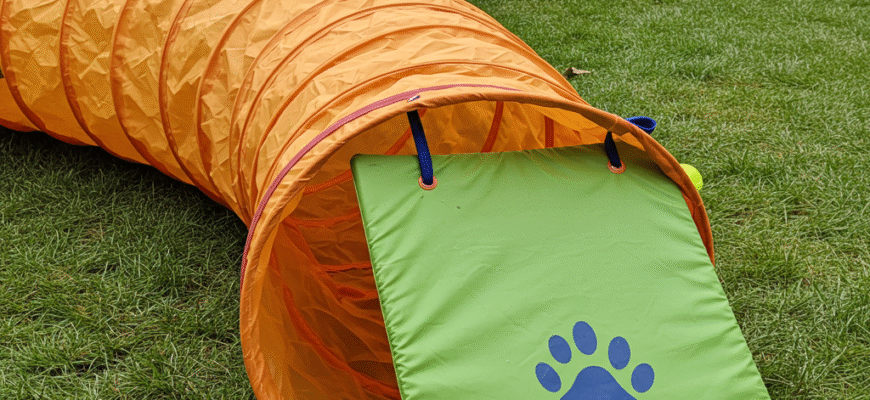Content
Why Go DIY for an Agility Tunnel?
Apart from the obvious cost savings compared to buying pre-made equipment, building your own tunnel has several advantages. You get to choose the length, diameter, and even the color, tailoring it perfectly to your pet’s size and your training space. It’s also a rewarding project that deepens the connection with your pet – you’re literally building their playground! Plus, knowing exactly what materials went into it gives you peace of mind about its safety and durability.Gathering Your Supplies
The beauty of this project lies in its simplicity and the use of readily available materials. Here’s what you’ll typically need:- Pop-Up Hampers or Collapsible Laundry Baskets: Look for cylindrical ones with a sturdy wire frame. The number you need depends on your desired tunnel length (usually 3-5 works well for a decent starter tunnel). Ensure they are roughly the same diameter.
- Fabric or Tarpaulin: This will be the tunnel’s skin. Choose something durable but flexible. Outdoor fabric, lightweight canvas, or a medium-weight tarp are good options. Measure the circumference of your hampers and multiply by the desired total length, adding extra for overlap and securing.
- Strong Zip Ties or Heavy-Duty Duct Tape: For connecting the hamper frames and potentially securing the fabric. Zip ties often offer a more secure, longer-lasting connection for the frame.
- Fabric Glue or Sewing Supplies: If you want a neater finish for the fabric cover, fabric glue or a sewing machine can be used. Heavy-duty tape is a no-sew alternative.
- Scissors or Fabric Shears: For cutting the fabric.
- Box Cutter or Strong Scissors: To carefully remove the bottoms of the hampers.
- Measuring Tape: Essential for accurate cutting.
Building Your Pet Agility Tunnel: Step-by-Step
Alright, let’s get building! Clear some space and lay out your materials.Step 1: Prepare the Hampers
Your pop-up hampers will form the skeleton of the tunnel. Most of these have a fabric bottom. You need to carefully remove this from all hampers except potentially the one you plan to use for the very end (leaving one end closed can sometimes help with initial training, though most agility tunnels are open at both ends). Use a box cutter or strong scissors to cut away the fabric bottom close to the wire edge. Be careful not to damage the main cylindrical fabric or the wire frame itself. Smooth out any rough edges where you cut.Step 2: Connect the Hamper Frames
Decide on the length of your tunnel and how many hampers you’ll connect. Place two hampers end-to-end, aligning the wire frames as closely as possible. Use strong zip ties to lash the end wires of the two hampers together. Secure them in at least 3-4 points around the circle for stability. Make sure the zip tie ends are trimmed flush and face outwards to avoid snagging your pet. Alternatively, you can use heavy-duty duct tape, wrapping it generously around the join, but zip ties generally hold up better over time, especially outdoors. Repeat this process, adding hampers one by one until you reach your desired tunnel length.Step 3: Create the Tunnel Cover
Lay your connected hamper frame on its side on top of your chosen fabric or tarp. Measure the circumference of the hampers (wrap the measuring tape around one). Add a few inches for overlap (essential for gluing or taping). Measure the total length of your connected hamper frame. Roll the frame along the fabric, ensuring you have enough width (circumference + overlap) and length. Cut the fabric to size. Carefully wrap the fabric around the connected hamper structure. You want a snug fit, but not so tight that it prevents the tunnel from flexing slightly. Secure the fabric along the seam where the edges overlap using fabric glue, heavy-duty duct tape, or by sewing if you prefer. Secure the fabric to the end hoops as well, folding it over the wire and taping or gluing it down securely.Step 4: Finishing Touches and Safety Check
Once the cover is attached, do a thorough check. Ensure there are no sharp edges from cut zip ties or exposed wires. Make sure the fabric is securely fastened and doesn’t have loose flaps that could trip your pet. The tunnel should feel sturdy but still have a little give, mimicking a professional agility tunnel. If using tape, press it down firmly everywhere. If using glue, allow it to dry completely according to the manufacturer’s instructions before introducing it to your pet.Important Safety Note: Always supervise your pet when they are using the agility tunnel, especially during initial training. Never force your pet into or through the tunnel if they show fear or hesitation. Ensure the tunnel is placed on a level surface and cannot easily roll away or collapse unexpectedly during use.









